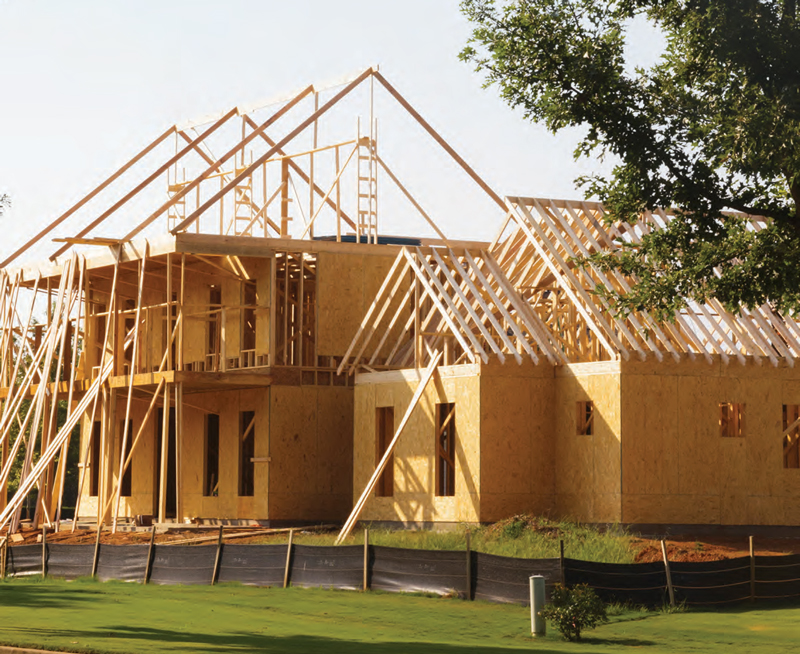If You Build It | Tips for Saving Money When Building Your Dream Home


Building the home of your dreams is an aspiration shared by millions of Americans, but building from the ground up can often seem like a prohibitively expensive proposition. It doesn’t have to be. If you take a systematic and practical approach, you might be able to achieve that ideal home within your budget. We reached out to local experts in the field of new construction for some tips and tricks to help keep expenses down while building your dream abode.
First and foremost, planning is everything. “Initial decisions to save money can be accomplished by planning ahead,” says Jane Blickenstaff, a 40-year real estate veteran and broker with Blickenstaff & Company. “Get a clear plan and stick to it.”
When choosing a builder or architect, Blickenstaff says, “It is important to interview them to get a clear understanding of not only pricing, timing and quality of their work, but who you think you could work with the best.” Ask for personal referrals from friends and family, and meet with multiple potential partners before choosing. “A good builder can make recommendations throughout the process to help you save money,” she says, so invest some time in finding the best one.
 Scott Elliott, president of Custom Structures, agrees. “Hire the right builder, and they will get you the best deal. We always ask our clients to interview at least three builders,” he explains. “Communication and trust is key to a successful project. Check with vendors and suppliers to ensure the builders are up to date on accounts and in good standing.” In addition, “Ask who is performing the work on your project,” advises Elliott. “Always make sure every subcontractor who is working on your project is licensed and insured.”
Scott Elliott, president of Custom Structures, agrees. “Hire the right builder, and they will get you the best deal. We always ask our clients to interview at least three builders,” he explains. “Communication and trust is key to a successful project. Check with vendors and suppliers to ensure the builders are up to date on accounts and in good standing.” In addition, “Ask who is performing the work on your project,” advises Elliott. “Always make sure every subcontractor who is working on your project is licensed and insured.”
Once you have your builder, you should have a contract spelling out what is included in the project and how the builder will get paid, advises Blickenstaff. Builders arrange payments in various ways. Some may prefer monthly payments, while others may arrange payments at different construction milestones. Make sure that these payments are outlined in your contract, and, if needed, coordinate payments with your lender.
As for financing, you have choices there as well. Research different lenders to learn about their specific programs. “Some construction loans can be converted to a mortgage with only one closing, which saves you on the closing costs,” says Blickenstaff. You should also look into locking in the interest rate, “So there are no surprises in your payment at the end.”
In fact, it would be smart to avoid surprises as much as possible in the process and get costs and pricing up front. For example, many builders will work with clients on “allowances” to cover the cost of certain items, and that dollar amount is included in the price of the project. This could include selections of tile, lighting and carpet. “If you make selections ahead of time, you can establish realistic allowances and add to your budget,” says Blickenstaff.
Experienced builders recommend paying close attention to those allowances in the bidding process. Not all builders are upfront with buyers, and it’s not unheard of for builders to work hard to craft the lowest bid, and then have customers who wind up paying more than expected because the allowances are too low for them to get what they want.
Get multiple bids and make sure to understand the breakdown of costs—knowing that lowest isn’t always smartest. “We have had clients come to us after they chose the lowest bidder and had unfortunate situations,” says Elliott, who always encourages potential clients to really do their homework. “If you are not sure what finishes you want, ask for allowances, but make sure they are realistic for the size home you are building.”
Along those lines, “Allow for a few places that you may want to splurge,” advises Blickenstaff. “For example, a kitchen backsplash is something that you will see many times a day for years, so you may want a special tile feature behind your range.” Account for the splurge, then find space for it in your budget.
Having a clear game plan will help avoid fees. “Add-ons and change orders are expensive,” says Blickenstaff. But, since some changes are inevitable, “Have a clear understanding of what the extra costs are and get all change orders in writing. It is important to know upfront in your contract how any change orders are charged and paid for.”
Blickenstaff says homebuilders should think in terms of assembling a specialized team. “Your main players are the builder and architect, but you may want to add team members such as an interior or kitchen designer,” says Blickenstaff, who herself holds an interior design degree. “Designers can help you create beautiful spaces and can save you costly mistakes.”
You can save money while also benefitting from design support if you purchase from a store that has a designer on staff. “If a designer is not in your budget but you need help with paint colors, for example, paint stores sometimes have staff members who have a good eye for color, and they can help at no charge,” says Blickenstaff.
After working for many years with numerous homebuilders throughout the construction process, Blickenstaff warns about the pitfalls of “it’s only a couple of hundred dollars” thinking. “That can catch up with you and blow your budget,” she says. “If you have to have something, think of tradeoffs. Get what you want, but move money from one bucket to another.”
On big ticket items, Blickenstaff says, watch for sales and be creative. “Buy your appliances on Black Friday. Most cabinet companies run seasonal sales as much as 10 percent off, and builders sometimes get better pricing on light fixtures, so ask your builder if they will allow you to purchase at their cost.”
Elliott recommends scoping out local deals on an ongoing basis. “If you are on a really tight budget, check the clearance aisles at Lowe’s and Home Depot each week,” he says. And don’t be shy. “You can usually talk them down even more from the marked down price.” He also suggests you look beyond the big box stores, searching for items at Habitat for Humanity re-sale stores, Craigslist and local Facebook pages.
You should also talk to your builder about any time-honored tricks of the trade you can employ. For example, instead of expensive custom cabinetry, have your builder secure stock cabinets, and then upgrade them with nicer doors and hardware, giving you the look you want for less overall cost.
It’s important to identify what’s important personally and where you want to spend money. “If you love to cook and a 48-inch, sixburner gas Viking range is a dream, and you will enjoy it every day, then do it,” says Blickenstaff. This is mainly because, “Some things you can add later and some things you won’t change.” If you have cabinets and granite designed for a basic range and vent hood, you will need a costly remodel to get that 48-inch range to fit. Instead, get what you want by shifting the funds. “Take your deck money and use it for your range, and add the deck later,” she suggests. Or build a concrete patio for the short term.
If you are building a home that you think you may sell in the near future, then engage your real estate agent, advises Blickenstaff. “Realtors know where you should spend the money to get the most return and what finishes are important in your price range. They will be glad to help—they will want your home to be as marketable as possible.”
If you are thinking about building your dream home, don’t let the initial price tag dissuade you. Thanks to some advice from experts in the field, you may be able to achieve your goal on time and under budget, making that dream a reality.
bids, Current Issue, Dream Home, financing, hiring builders, homebuilders






